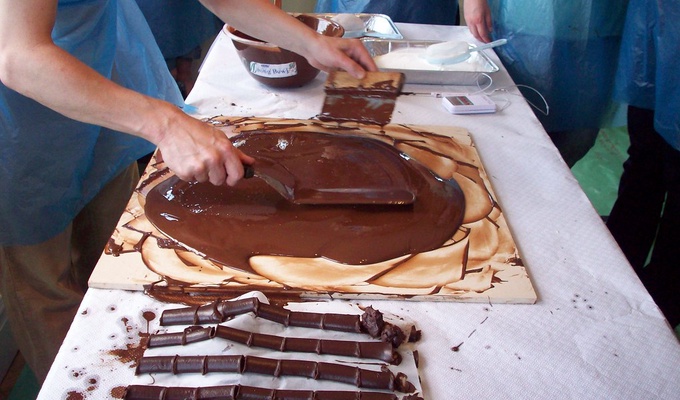Tempering (in chocolate) is the process of controlling the formation of solid crystals of cocoa butter in a mixture of liquid cocoa butter and chocolate liquor as it cools. Chocolate that contains a uniform set of crystals of the right type is shiny, with consistent color, and breaks with a clean snap rather than bending or crumbling. It has a melting point that is close to body temperature, allowing it to stay solid in the hand but melt in the mouth. When properly tempered and stored at an appropriate temperature, chocolate will stay tempered for months.
The fats in cocoa butter can crystallize in six different forms, or phases. The goal of tempering is to produce a solid that contains only the fifth phase (called phase V). This is primarily achieved through temperature control, since the melting point of each phase is slightly different, as seen in this chart:
- Phase I: Melts at 17° C (63° F). Soft and crumbly, melts easily.
- Phase II: Melts at 21° C (70° F). Soft and crumbly, melts easily.
- Phase III: Melts at 26° C (79° F). Firm, with a poor snap, and melts easily.
- Phase IV: Melts at 28° C (82° F). Firm, with a good snap, but melts easily at external body temperature.
- Phase V: Melts at 34° C (93° F). Firm and glossy, with clear, sudden snap, melts at very close to human body temperature (37° C)
- Phase VI: Melts at 36° C (97° F). Quite hard; forms slowly from phase V during exposure to air.
Chocolate with higher milk fat or cocoa butter content has a lower melting point and must be tempered at correspondingly lower temperatures.
The goal of a chocolatier is to manipulate the chocolate so that it forms Phase V crystals when it is cooled in its final configuration, which could be a mold, a filling, or a covering ("couverture") of another confection.
The difficulty of tempering chocolate in home kitchens or industrial settings has led to creation of manufactured [compound coating|compound coatings], which are chocolate-styled products made with fats other than cocoa butter — such as palm kernel oil or vegetable fats — which do not require tempering and solidify reliably without precise temperature control.
Tempering techniques
When tempering chocolate, a chocolatier will first heat the chocolate to at least 45° C (113° F) to melt all the cocoa butter crystals and achieve a homogenous mass. The chocolate is then carefully cooled to 27° C (81° F), which is just below the melting point of phase IV, and therefore allows phase IV and V crystals to form. The chocolate is then either agitated, by mechanical or manual processes, to produce crystalline seeds that will act as nuclei for further crystal formation, or "seeded" with finely-chopped tempered chocolate, which contains phase V nuclei that will disperse into the mass as they slowly melt apart.
The chocolate is then gently heated to around 31° C (93° F), which eliminates the phase IV crystals, leaving the phase V crystals in place. So long as the chocolate is kept between 28° and 31° C, the chocolate will remain in temper and can be used for pouring, enrobing, and dipping.
Tempering flaws
When chocolate is not properly tempered, either due to uncontrolled cooling or improper storage, a variety of flaws are revealed.
- Chocolate bloom, or fat bloom, results when phase I through IV crystals of cocoa butter rise to the surface of the chocolate, creating gray or white streaks on the surface of the chocolate. This often results when chocolate is exposed to temperatures above or below the critical 28 to 31° C range.
- Sugar bloom results when moisture penetrates the chocolate's crystalline structure and dissolves the sugar, which then migrates to the surface and is deposited there as a rough white powder when the water evaporates. It is the result of storage in high-humidity environments or when refrigerated chocolate is exposed to humid air, causing condensation.
- Poor snap, or "bendy" chocolate results when many phase I through IV crystals are present.
- Streaking, or marbling, results from poor distribution of crystals during tempering, typically because of improper agitation or disruption during cooling.
